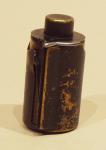|
|
The Berning Robot can be considered as the first motor-driven camera.
 The Berning Robot was first introduced in 1934, at a time when 35 mm film was becoming the new standard but the 135 cartridge didn't yet. Designed by Heinz Kilfitt and made by Düsseldorf-based Otto Berning & co., the Robot was the only 35 mm alternative to the Zeiss Contax and Leicas. Like the Leicas, it was part of the equipment of many German air force pilots during World War II. Those, like the one on the picture, had "Luftwaffen Eigentum" engraved on the body and lens. The Robot remained in production long after the end of the war.
The Berning Robot was first introduced in 1934, at a time when 35 mm film was becoming the new standard but the 135 cartridge didn't yet. Designed by Heinz Kilfitt and made by Düsseldorf-based Otto Berning & co., the Robot was the only 35 mm alternative to the Zeiss Contax and Leicas. Like the Leicas, it was part of the equipment of many German air force pilots during World War II. Those, like the one on the picture, had "Luftwaffen Eigentum" engraved on the body and lens. The Robot remained in production long after the end of the war.
The Robot is a peculiar camera in many ways. It is very compact and heavy. It makes 24 x 24mm pictures, allowing to make up to 60 shots on a 36 shots film. It has two viewfinders : one in the lens axis and one at 90° for "spy work". It has no light meter or rangefinder. Pre-1945 versions used special film cartridges loaded with standard 35 mm film. Lenses, made by Zeiss and Schneider - Kreuznach, used a 26 mm screw mount. Available focal lengths ranged from 30 mm to 400 mm The model on the picture is fitted out with a 4 cm f/2 Zeiss Biotar.
 But the main characteristic of the Robot is that it was the first motor-driven camera. It was powered by a spring motor wound up with the big knob on top of the camera. When fully wound up it could take up to 24 shots in a row. With some practice it can take up to two or three shots per second. But the main characteristic of the Robot is that it was the first motor-driven camera. It was powered by a spring motor wound up with the big knob on top of the camera. When fully wound up it could take up to 24 shots in a row. With some practice it can take up to two or three shots per second.
 |
Use |
|
 The biggest problem of the Robot II is the necessity of reloading its special cartridge (picture on the left) with modern 35 mm film. This operation is quite straightforward : open the film, put the spool in the cartridge, close it, you're done. But this must be done in complete darkness, which is not so easy to find, unless one can find the rare special reloader.
The biggest problem of the Robot II is the necessity of reloading its special cartridge (picture on the left) with modern 35 mm film. This operation is quite straightforward : open the film, put the spool in the cartridge, close it, you're done. But this must be done in complete darkness, which is not so easy to find, unless one can find the rare special reloader.
This camera is very sturdy and its settings are quite simple : One just need to adjust the diaphragm, the distance and the speed. There is no lightmeter nor rangfinder.
The Robot II is a funny camera to use. With its square format and old lenses it makes very peculiar pictures full of possibilities. But if one intends to use it on a regular basis, the Robot Star is a far better choice.
 |
Characteristics |
|
Format |
24 x 24 mm (on 35 mm film) |
Lens |
26 mm screw mount, focal lengths from 30 mm to 400 mm |
Shutter |
behind the lens, from 1/500 s to 1/2 s plus B pose, M flash synchronisation at all speeds |
Weight |
820 g with the 40 mm Biotar |
 |
Sound |
|
|
 .wav file .wav file
67 ko
|
The sound goes "crick-crick-crick click-bzzz click-bzzz click-bzzz". The crick-crick-crick is the sound of the winding of the spring motor. The three click-bzzz are three shots taken in a row at 1/500 s, the click being the sound of the shutter and the bzzz the motorized film advance. |
 |
Sample pictures
|
|
 |
Links
|
|
The complete story of the Robot on the Sub Club website An exhaustive and illustrated list of all Robots on the Robot Empire website. This site is strongly inspired by the Robot Historica book. A very neatly illustrated page about the Robot on CameraQuest An exhaustive site on all Robot cameras and accessories (in German)
|